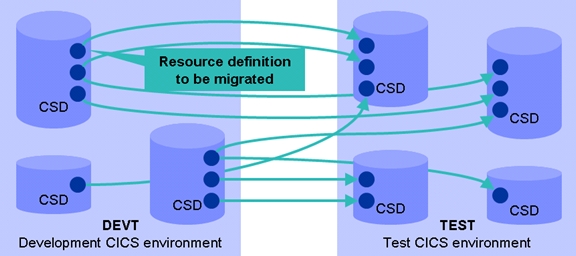| Tool Mentor: CICS CM – Deployment Management |
 |
|
| Related Elements |
|---|
ContextTool mentors explain how a tool can perform tasks, which are part of ITUP processes and activities. The tasks are listed as Related Elements in the Relationships section. You can see the details of how processes and activities are supported by this tool mentor, by clicking the links next to the icons: DetailsTo manage the release of CICS resource definitions, use IBM®® CICS Configuration Manager for z/OS (CICS CM). CICS CM allows you to build a framework for controlling the migration of CICS resource definitions across your applications life cycle.
1. A migration scheme is the conceptual model that defines
the migration path – the lifecycle of CICS resource definitions. Typically, organizations migrate resource definitions
between environments according to well-defined pathsl For example, from development to the test environment, and
then from test to production. Migration schemes can support very complex topologies. The source or target nodes may reference CSD files or CPSM contexts in any combination. The scheme may have one, two, or many source-to-target combinations. One-to-one, one-to-many, and many-to-one topologies are supported.  2. Migration schemes may refer to transformation rules that can alter resource definition attributes during migration, or stop migration of certain resource definitions. Use transformation rules to change definitions automatically as they are migrated through the life cycle. Each transform rule consists of three parts: i. Qualification criteria determine if the rule applies to specific resources. The criteria are assessed against the source resource to be migrated. If all the qualification conditions prove true, then the rule applies. ii. The processing option instructs CICS CM what action to take. There are four options: a) Apply the transformation, and continue processing the source resource with other transformation rules b) Apply the transformation and continue processing, but lock the transformed field so that it can't be changed any further c) Apply the transformation, but stop further transformations for this resource d) Stop the migration of this resource. No transformation or copying of this resource will occur iii. The attribute or field to be transformed is identified along with the change-from and change-to values. The change-from and change-to values may include masking characters. 3. Use exits to extend and customize CICS CM server processing and workflow. For example: · Notify users of planned or completed activity · Log information regarding completed activity · Trigger an event to an external change management system · Check a user's authority to perform the designated function · Obtain a proceed-or-terminate decision from an external change management product · Enforce standards for resource definition attribute values 4. Use approval profiles to define roles (or link to SCLM approvals) Approval profiles identify the approvals required to migrate a change package using a specific migration scheme. For each migration scheme, the approval profile specifies up to five approver roles. The roles define the types of user who must approve the change package before it can be migrated using that migration scheme. A change package is fully approved when all of the applicable approver roles have approved it. For more informationFor more information about this tool, go to the IBM CICS Configuration Manager page. |
©Copyright IBM Corp. 2005, 2008. All Rights Reserved. |